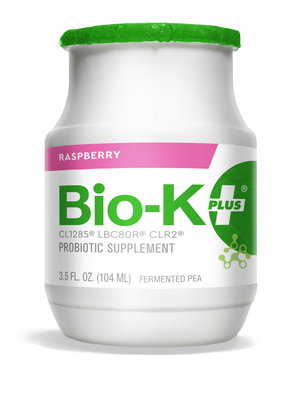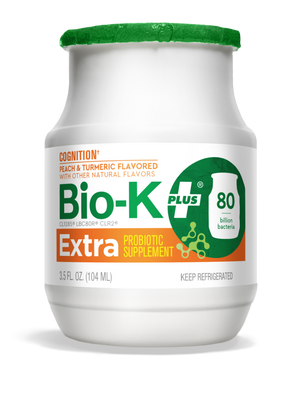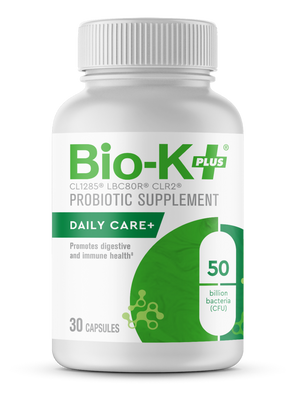Understanding Lactose Intolerance and its Effects on the Gut
It is estimated that approximately 7 million Canadians suffer from lactose intolerance [1]. Among the main irreversible causes of lactose intolerance is genetics, including a declining prevalence of lactase activity in some people. Among the usually transient and reversible secondary causes that can also lead to lactose intolerance are types of intestinal mucosal injuries such as celiac disease, intestinal infections due to intestinal parasites, the use of certain drugs, and more. These influence the production of lactase, the first enzyme affected during abdominal trauma, causing certain adverse effects [2].
What is Lactose?
Lactose is a disaccharide, a sugar composed of two simple sugars (or monosaccharides): galactose and glucose. There is a decrease in the activity of lactase—the enzyme that breaks lactose down into simple elements and adequately absorbs lactose—in people who are intolerant. The ingested lactose then produces an osmotic reaction in the intestine. When it is not properly fragmented, the undigested disaccharide enters the large intestine where it will begin fermentation:
“Because it is a large sugar molecule that cannot be absorbed in and of itself, lactose produces an osmotic reaction in the intestine. This results in a call for water in the intestinal lumen, explaining the more or less rapid occurrence of watery diarrhea.” [2]
While lactose intolerance is not dangerous, the symptoms associated with it—intestinal gas, cramping, diarrhea and nausea—can be very uncomfortable.
What’s the Difference Between Milk Allergy and Lactose Intolerance?
Lactose intolerance can be permanent or temporary. It occurs when our body is deficient in the lactase enzyme, leading to lactose malabsorption. Certain digestive tract diseases (such as Cohn’s disease, ulcerative colitis, and celiac disease) cause damage to the small intestine and have been associated with lactose malabsorption. Thus, when lactose intolerance is caused by an injury to the small intestine, the condition may be temporary and symptoms may improve once the intestine is healed [3].
A milk allergy, on the other hand, is the body’s abnormal immune response to milk and products containing milk—Cow’s milk is usually the culprit, but sheep, goat and buffalo milk can also be the source of the allergy. The signs and symptoms of a milk allergy present themselves differently for everyone, and the intensity might also vary. Symptoms might include wheezing, vomiting, hives, digestive problems and in some cases anaphylaxis. It is important to consult your health specialist if ever you are experiencing any of these symptoms.
Milk allergy usually shows up early in life, while lactose intolerance can show up at any time, either due to genetics, to damages caused to the small intestine, or due to ageing.
Foods to Avoid when Lactose Intolerant
While most people with lactose intolerance can tolerate some lactose, limiting your exposure to lactose foods and lactose-containing ingredients is the best course of action. The following are a list of ingredients containing lactose:
- Whey
- Caseinates
- Nougat
- Cheese
- Milk by-products
- Dry milk solids
- Lactose
- Butter
- Curds
- Non-fat dairy milk
- Dry milk powder
Lactose is also present in about 20% prescription medications such as birth control pill and 6% of over the counter medications such as antacids [3].
Digestive Health and Lactose
If you are lactose intolerant, optimizing your digestive health becomes critical, as well as taking special consideration with your diet to ensure you are getting all the nutrients your body needs.
Probiotics have been shown to be a useful tool in reducing symptoms associated with lactose intolerance, as well as optimizing digestive health and promoting nutrient absorption [4].
What about Nutritional Deficiency?
If you do choose to avoid dairy entirely, ensure you are getting enough calcium and vitamin D in your diet to prevent any nutrient gaps.
Non-dairy sources of calcium include salmon (with bones), sardines, fortified soy products, and leafy greens. New drinkable Bio-K+ Coconut (fermented pea and hemp) is another great way to get some of your daily calcium as it contains 4% of your DV (Daily Value) per bottle.
For Vitamin D, in the summer months, be sure to get at least 10 minutes of sun exposure each day. In the winter, look for foods that are fortified with vitamin D or increase your consumption of egg yolk, liver, and fish.
At Bio-K+ we’re happy to offer both dairy and lactose-free non-dairy probiotics (fermented pea & hemp, fermented rice and fermented soy). We work hard to promote your digestive health and remain available to answer your questions on digestive health and probiotics.
Do you have any other questions about your gut health? Ask us in comments below. If you are looking to stock up on Bio-K+, head to our store locator. For more information on Bio-K+, probiotics and digestive health, contact us, find us on Facebook and Instagram or join our community.
References
- https://cdhf.ca/digestive-disorders/lactose-intolerant/what-is-lactose-intolerance
- http://www.professionsante.ca/files/2012/05/LAP63_001-004.pdf
- https://my.clevelandclinic.org/health/diseases/7317-lactose-intolerance
- https://www.ncbi.nlm.nih.gov/pubmed/17927751
- https://www.dietitians.ca/Downloads/Factsheets/Managing-Lactose-Intolerance.aspx





